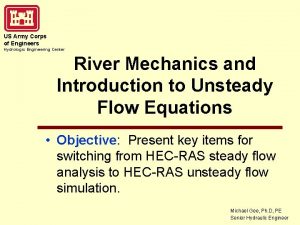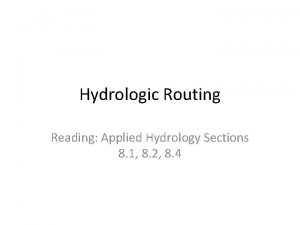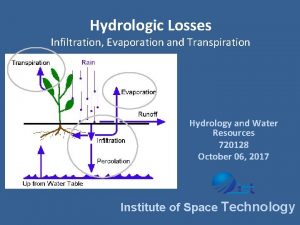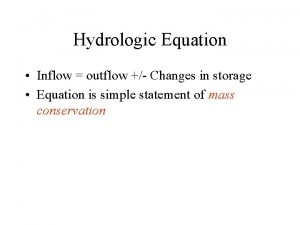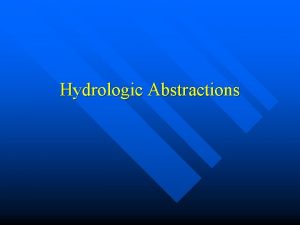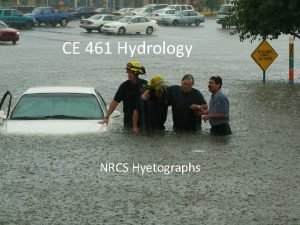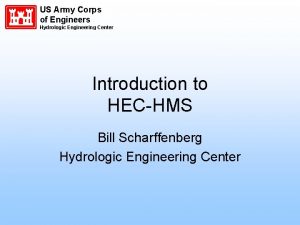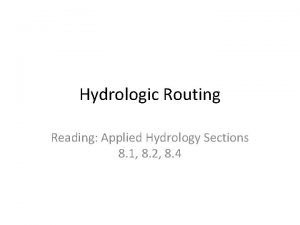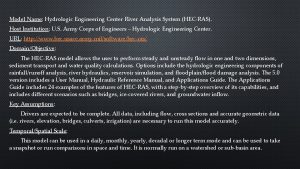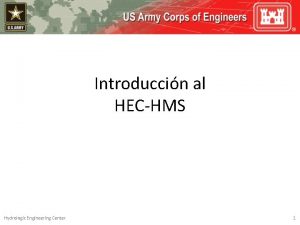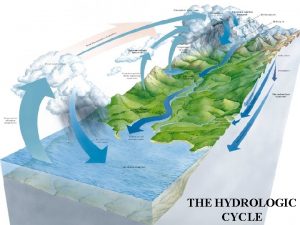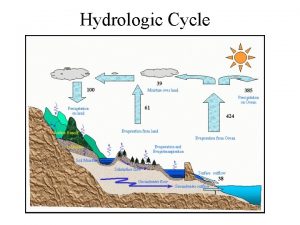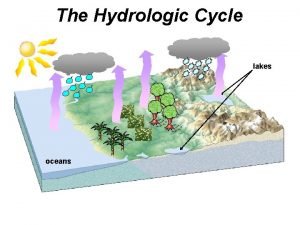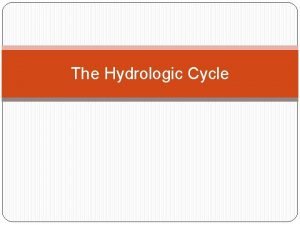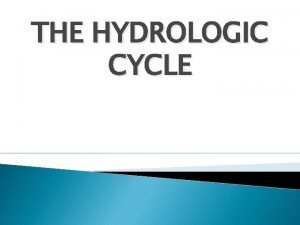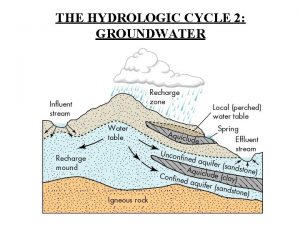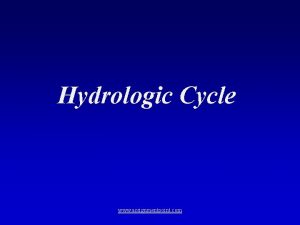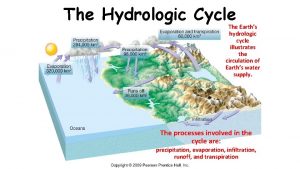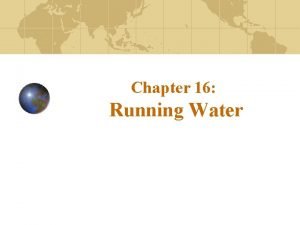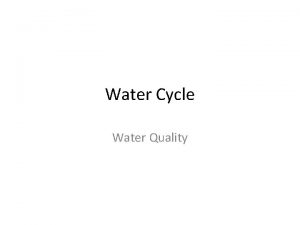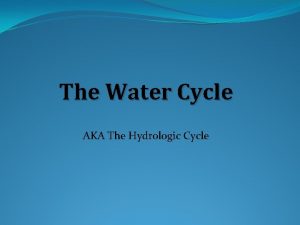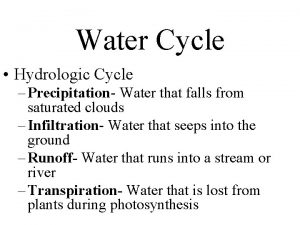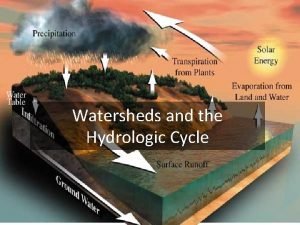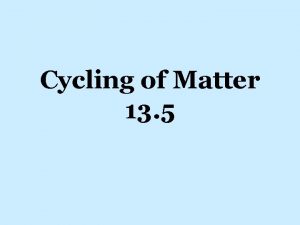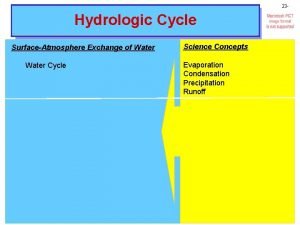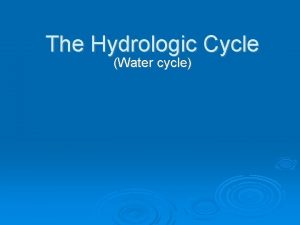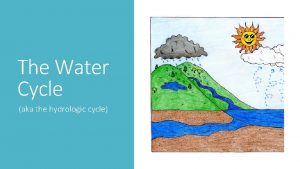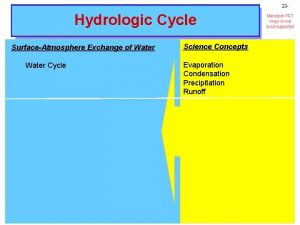Water Hydrologic cycle p The hydrologic cycle is





































- Slides: 37

Water

Hydrologic cycle p. The hydrologic cycle is a summary of the circulation of Earth’s water supply p. Processes involved in the hydrologic cycle p Evapotranspiration p Condensation p Precipitation p Infiltration p Runoff

The water cycle

Distribution of Earth’s Water




Running water p Begins as sheetflow p. Infiltration capacity depends on § Intensity and duration of rainfall § Prior wetted condition of the soil § Soil texture § Slope of the land § Nature of the vegetative cover p. Sheetflow develops into tiny channels called rills

Running water p. Changes from upstream to downstream p. Profile §Cross-sectional view of a stream §Viewed from the head (headwaters or source) to the mouth of a stream

Longitudinal profile of a stream

Changes from upstream to downstream p. Factors that increase downstream §Velocity §Discharge §Channel size

Changes from upstream to downstream p. Factors that decrease downstream §Gradient §Channel roughness p. Base level is the lowest point to which a stream can erode

Adjustment of base level to changing conditions

Running water p. Stream valleys are the most common landforms on Earth’s surface p. Types of stream valleys §Narrow valleys V-shaped § Downcutting toward base level § Features often include rapids and waterfalls §



Running water p. Stream valleys p. Two general types of stream valleys §Wide valleys Stream is near base level § Downward erosion is less dominant § Stream energy is directed from side to side forming a floodplain §

Features of wide valleys p. Floodplains p. Meanders § Cut bank and point bar § Cutoffs and oxbow lakes





Meandering Channel

Drainage patterns

http: //www. al. nrcs. usda. gov/technical/photo/wet/veg/wetlands 3. jpg

Define: wetlands pa low-lying area of land that is saturated with moisture. For example: Marshes, swamps, and bogs are examples. www. google. com/url? sa=X&start=17&oi=define&q=http: //www. thehenryfo

Define: wetlands p “those areas that are inundated or saturated by surface or ground water at a frequency and duration sufficient to support, and that under normal circumstances do support, a prevalence of vegetation typically adapted for life in saturated soil conditions” www. google. com/url? sa=X&start=1&oi=define&q=http: //www. epa. gov/OC

Wetlands p High diversity n p Transitional zone to upland Classification – Cowardin system n n n Marine wetlands – coral reefs, rocky shorelines, salt water Estuarine wetlands – tidal salt marsh, mangrove swamps, strong tidal influence Riverine wetlands – transitional area to upland, high species diversity, high productivity Lacustrine wetlands – lakes, ponds Palustrine – bogs, fens, peatlands

Wetlands are transition zones

Wetlands are transition zones

Wetlands are transition zones http: //www. pbase. com/roamer 8/image/57048104

http: //ecosystems. mbl. edu/pie/data/MAP/plumisla. jpg

Who cares about wetlands? p Hydrologic processes Intercept runoff and store it to reduce flooding p Stabilize streambanks p Contribute to recharge and discharge of groundwater p p Water quality improvement p p Remove sediment, toxins, nutrients from water Wildlife habitat High primary productivity (abundant plant life) p Abundant and diverse wildlife p

Wetland protection p Gradual recognition of values n Wetland removal sequence 1980’s No net loss policy p Heavy regulation of wetland management p

http: //pictures. exploitz. com/Reflection-Lakes-thumbnail-Seattle--_tngpx 10001 x 15046 x 1 cdfd 8366. jpg

Lakes p Littoral zone – shallow, rooted vegetation dominated margin of a lake n p Key wildlife habitat area Thermal stratification n Winter p n Spring p n Mixing of water (agitated by wind) Summer p n Ice formation – creates zone for fish life Thermocline (most oxygen in upper layers Fall p Temperature unifies as air cools, mixing of water

http: //www. fishsniffer. com/guest/images/041103 lakezones. gif
 Water cycle the hydrologic cycle
Water cycle the hydrologic cycle Water and water and water water
Water and water and water water Hydrologic engineering center
Hydrologic engineering center Reservoir flood routing worked examples
Reservoir flood routing worked examples Hydrologic routing
Hydrologic routing Hydrologic losses
Hydrologic losses Storage equation
Storage equation Hydrologic abstractions
Hydrologic abstractions Hydrologic routing and hydraulic routing
Hydrologic routing and hydraulic routing Objectiveable
Objectiveable Continuity equation hydrology
Continuity equation hydrology Hydrologic engineering center
Hydrologic engineering center Hydrograph
Hydrograph River analysis system
River analysis system Hydrologic engineering center
Hydrologic engineering center How is the carbon cycle similar to the water cycle brainpop
How is the carbon cycle similar to the water cycle brainpop Hình ảnh bộ gõ cơ thể búng tay
Hình ảnh bộ gõ cơ thể búng tay Lp html
Lp html Bổ thể
Bổ thể Tỉ lệ cơ thể trẻ em
Tỉ lệ cơ thể trẻ em Gấu đi như thế nào
Gấu đi như thế nào Thang điểm glasgow
Thang điểm glasgow Hát lên người ơi
Hát lên người ơi Môn thể thao bắt đầu bằng từ đua
Môn thể thao bắt đầu bằng từ đua Thế nào là hệ số cao nhất
Thế nào là hệ số cao nhất Các châu lục và đại dương trên thế giới
Các châu lục và đại dương trên thế giới Công thức tính độ biến thiên đông lượng
Công thức tính độ biến thiên đông lượng Trời xanh đây là của chúng ta thể thơ
Trời xanh đây là của chúng ta thể thơ Mật thư anh em như thể tay chân
Mật thư anh em như thể tay chân 101012 bằng
101012 bằng Phản ứng thế ankan
Phản ứng thế ankan Các châu lục và đại dương trên thế giới
Các châu lục và đại dương trên thế giới Thơ thất ngôn tứ tuyệt đường luật
Thơ thất ngôn tứ tuyệt đường luật Quá trình desamine hóa có thể tạo ra
Quá trình desamine hóa có thể tạo ra Một số thể thơ truyền thống
Một số thể thơ truyền thống Cái miệng xinh xinh thế chỉ nói điều hay thôi
Cái miệng xinh xinh thế chỉ nói điều hay thôi Vẽ hình chiếu vuông góc của vật thể sau
Vẽ hình chiếu vuông góc của vật thể sau Biện pháp chống mỏi cơ
Biện pháp chống mỏi cơ


